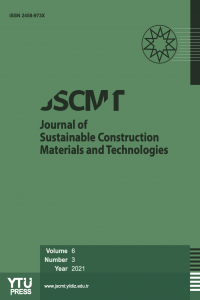Building a User-Friendly LCI Prediction Model for Concrete Mixtures
Building a User-Friendly LCI Prediction Model for Concrete Mixtures
___
- Benhelal, E., Zahedi, G., Shamsaei, E., & Bahadori, A. (2013). Global strategies and potentials to curb CO2 emissions in cement industry. Journal of Cleaner Production, 51, 142–161. doi:10.1016/j.jclepro.2012.10.049 Bilec, M., Ries, R., Matthews, H. S., & Sharrard, A. L. (2006). Example of a hybrid life-cycle assessment of construction processes. Journal of Infrastructure Systems, 12(4), 207–215.
- Boesch, M. E., Koehler, A., & Hellweg, S. (2009). Model for Cradle-to-Gate Life Cycle Assessment of Clinker Production. Environmental Science & Technology, 43(19), 7578–7583. doi:10.1021/es900036e
- De Schepper, M., Van den Hedde,P., Van Driessche, I., & De Belie, N. (2014). Life Cycle Assessment of Completely Recyclable Concrete. Materials 2014, 7, 6010-6027; doi:10.339/ma7086010
- DeVierno, A., Thorn, B., & Carrano, A.L. (2012) Combining Life Cycle Assessment and Linear Regression Analysis to Determine Significant Design Characteristics, ASME 2012 International Design Engineering Technical Conferences and Computers and Information in Engineering Conference, Chicago, IL, Volume 5.
- Flower, D. J. M., & Sanjayan, J. G. (2007). Green house gas emissions due to concrete manufacture. The International Journal of Life Cycle Assessment, 12(5), 282–288. doi:10.1065/lca2007.05.327
- Habert, G & Roussel, N. (2009). Study of two concrete mix-design strategies to reach carbon mitigation objectives. Cement & Concrete Composites, doi: 10.1016/j.cemconcomp.2009.04.001
- Hanes, R., Bakshi, B.R., & Goel, P.K. (2013) The Use of Regression in Streamlined Life Cycle Assessment. Proceedings of the International Symposium on Sustainable Systems and Technologies, v1.
- Huntzinger, D. N., & Eatmon, T. D. (2009). A life-cycle assessment of Portland cement manufacturing: comparing the traditional process with alternative technologies. Journal of Cleaner Production, 17(7), 668–675. doi:10.1016/j.jclepro.2008.04.007
- Kim, H. K., & Lee, H. K. (2013). Effects of High Volumes of Fly Ash, Blast Furnace Slag, and Bottom Ash on Flow Characteristics, Density, and Compressive Strength of High-Strength Mortar. Journal of Materials in Civil Engineering, 25(5), 662–665. doi:10.1061/(ASCE)MT.1943-5533.0000624.
- Knoeri, C., Sanyé-Mengual, E., & Althaus, H.-J. (2013). Comparative LCA of recycled and conventional concrete for structural applications. The International Journal of Life Cycle Assessment, 18(5), 909–918. doi:10.1007/s11367-012-0544-2Marceau, M., Nisbet, M. A., & Van Geem, M. G. (2006). Life Cycle Inventory of Portland Cement Manufacture. Portland Cement Association Skokie, IL. Retrieved from
- http://www.nrmca.org/taskforce/item_2_talkingpoints/sustainability/sustainability/sn2095b%20- %20cement%20lci%202006.pdf
- Marceau, M., & VanGeem, M. G. (2003). Life cycle inventory of slag cement manufacturing process (Life Cycle Inventory No. 312012). Skokle, Illinois: Construction Technology Labratories Inc.
- Marinković, S., Radonjanin, V., Malešev, M., & Ignjatović, I. (2010). Comparative environmental assessment of natural and recycled aggregate concrete. Waste Management, 30(11), 2255–2264. doi:10.1016/j.wasman.2010.04.012
- Menten, F., Cheze, B., Patouillard, L. and Bouvart, F. (2013) A Review of LCA greenhouse gas emissions results for advanced biofuels: The use of meta-regression analysis. Renewable and Sustainable Energy Reviews, 26, 108- 134.
- O’Brien, K. R., Ménaché, J., & O’Moore, L. M. (2009). Impact of fly ash content and fly ash transportation distance on embodied greenhouse gas emissions and water consumption in concrete. The International Journal of Life Cycle Assessment, 14(7), 621–629.
- Park, J.H., & Seo, K.K. (2003) Approximate Life Cycle Assessment of Product Concepts Using Multiple Regression Analaysis and Artificial Neural Networks. KSME International Journal, 17(12), 1969-1976.
- Pascual-Gonzalez, J., Pozo, C., Guillen-Gosalbez, G., & Jimenez-Esteller, L. (2015) Combined use of MILP and multi-linear regression to simplify LCA studies. Computers and Chemical Engineering, 82(2), 34-43.
- Petek Gursel, A., Masanet, E., Horvath, A., & Stadel, A. (2014). Life-cycle inventory analysis of concrete production: A critical review. Cement and Concrete Composites, 51, 38–48. doi:10.1016/j.cemconcomp.2014.03.005
- Purnell, P., & Black, L. (2012). Embodied carbon dioxide in concrete: Variation with common mix design parameters. Cement and Concrete Research, 42(6), 874–877. doi:10.1016/j.cemconres.2012.02.005
- Schwab, J. (2014). Literature Review on the State of Research on the Environmental Impact of Concrete. Internal report submitted to the Department of Engineering Technology, Texas State University.
- Sjunnesson, J. (2005, September). Life Cycle Assessment of Concrete (Masters’ Thesis). Lund University, Lund, Sweden.
- Van den Heede, P., & De Belie, N. (2012). Environmental impact and life cycle assessment (LCA) of traditional and “green” concretes: Literature review and theoretical calculations. Cement and Concrete Composites, 34(4), 431– 442. doi:10.1016/j.cemconcomp.2012.01.004
- Wang, L., Li, F., Li,J., & Wang, X. (2010) Sensitivity and uncertainy analysis of life-cycle assessment based on multivariate regression analysis. ICRM 2010 Green Manufacturing, Ningbo, China
- Başlangıç: 2016
- Yayıncı: Yıldız Teknik Üniversitesi
Investigating High-Speed Railways In Terms Of The Economy For Our Country and The Region
Onur ŞAHİN, Mehmet Fatih ALTAN
Characterization of Waste Bamboo Strips Underscoring Node Effects
Mohammad İrfan IQBAL, S. M. Fijul KABİR, Mohammad Abu Nasir RAKİB, Mohammad Mamunur RASHİD, Partha Pratim SİKDAR
Cibali District; Investigation of External Facing Material Selection In Architectural Structures
Building a User-Friendly LCI Prediction Model for Concrete Mixtures
